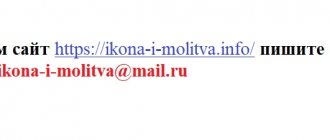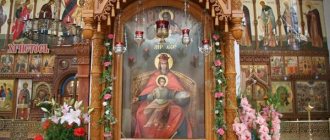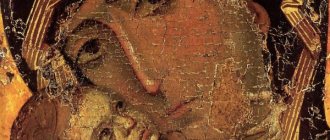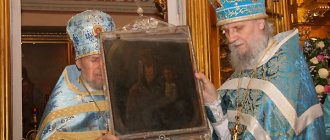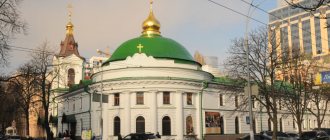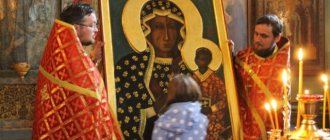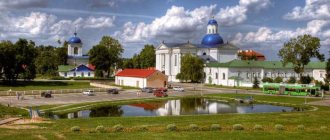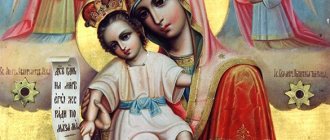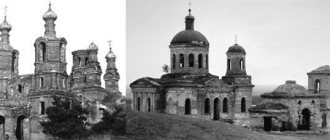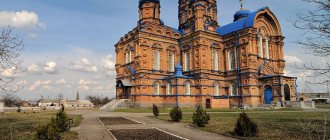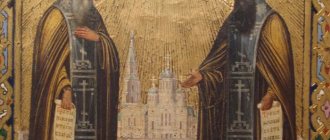"Save me, God!".
Thank you for visiting our website, before you start studying the information, please subscribe to our Orthodox community on Instagram, Lord, Save and Preserve † - https://www.instagram.com/spasi.gospodi/. The community has more than 60,000 subscribers. There are many of us like-minded people and we are growing quickly, we post prayers, sayings of saints, prayer requests, and timely post useful information about holidays and Orthodox events... Subscribe. Guardian Angel to you!
One of the revered icons of Orthodoxy is the Bethlehem Icon of the Mother of God. This image of the Virgin Mary has a little history. Some historians believe that this image was painted in ancient Rus'. There is also an opinion that it was written by the prophet icon painter Luke during the life of the Virgin Mary. It is for this reason that it is believed that this image shows as accurately as possible what the Virgin Mary looked like during her lifetime.
According to one of the legends, Luke painted three images and showed one of them to the Virgin Mary herself. She liked the image very much, and she blessed it, adding that grace would come to everyone who prayed in front of it. In addition to this image, Luke painted several more icons that depict saints authentically. It should also be noted that this is the only image of the Virgin Mary in which she smiles.
Back in 463, the Scythians tried to capture Constantinople. In order to enlist the support of the Lord and gain success in the intercession of the city, the Emperor’s wife brought an icon of the Mother of God of Bethlehem. Thanks to prayers and faith, the city was defended and not given to the Scythians.
This was the first miracle created in a holy image. Since then, the miracles created by the face of the Mother of God have not stopped. Everyone who comes to him with prayer finds success in business and all kinds of help.
The best article for you, go to: Icon of the Nativity of Christ, meaning and what it helps with
The meaning of the holy face
The image of the Blessed Virgin Mary of Bethlehem was painted in Russia by order of the emperor's family as a Christmas gift. There are quite a lot of stories and miracles associated with this icon, one of them is the healing of the princess from a serious incurable illness after a pilgrimage. By the way, it was from the dress of Princess Elizabeth, later recognized as a great martyr, that the frame and decoration of the icon were made.
Bethlehem Icon of the Mother of God
On a note! For the Russian icon painting school, an image of this kind is not typical, because the faces of saints on the canvases of famous icon painters are always full of sadness, suffering or humility, but the face of the Virgin Mary from the Bethlehem icon is illuminated with a smile.
Art historians believe that this type of icon belongs to the “digitria”, in other words, a guide icon. In Orthodox Christianity there are several icons of this type, they include:
- icon of the Smolensk Mother of God;
- icon of the Tikhvin Mother of God;
- icon of the Mother of God, Helper of Sinners;
- Icon of the Kazan Mother of God.
The meaning of such icons is to guide people who believe in Christ on the true path, which is always indicated in the image by the hand of the Virgin Mary, pointing in a certain direction. For every Christian, Jesus is such a road, like the path to the Garden of Eden, to eternal life.
Prayer text
I sing Thy grace, O Lady, I pray to Thee, my mind is filled with grace. Go right and instruct me in the path of Christ’s commandments. Strengthen your children to song, driving away despondency and sleep. Bound by the captivity of the Falls, allow me through Your prayers, Bride of God.
Preserve me in the night and in the day, delivering me to those who fight against the enemy. She who gave birth to God, the life-giver, was killed by my passions and revived. Who gave birth to the non-evening light, enlighten my blind soul. O wondrous Lady of the Palace, create for me the house of the Divine Spirit. You who gave birth to a doctor, heal my soul of many years of passion.
Worried by the storm of life, guide me towards the path of repentance. Deliver me from eternal fire, and from evil worms, and from tartar. Do not show me joy as a demon, who is guilty of many sins. Create me again, having promised to be insensible, Immaculate, without sin. Show me the strangeness of all kinds of torment, and implore the Lord to all. Heavenly grant me joy, with all the saints.
Most Holy Virgin, hear the voice of Your indecent servant. Give me a stream of tears, Most Pure One, cleansing the filth of my soul. I bring groans from my heart to You continually, be zealous to the Lady. Accept my prayer service and bring it to the blessed God. Transcending Angel, create me above the fusion of the world.
Light-bearing heavenly Seine, direct spiritual grace in me. I lift up my hand and my lips to praise, defiled by filth, O All-Immaculate One. Deliver me from the dirty tricks that are strangling me, diligently beseeching Christ, to whom honor and worship are due, now and ever and unto ages of ages. Amen.
What does an icon help with?
The image of the Mother of God of Bethlehem glorifies the infant Christ as the founder of a new, Christian world. This is indicated by the palm of the Mother of God, and the scepter as a symbol of power in the hands of the baby. The symbolic meaning of the icon can thus be expressed in a couple of words - Jesus is the ruler of the world.
Based on the meaning of the icon, we can say that in addition to helping the Mother of God in motherhood, this face helps a person to come to a pure righteous life, choosing the commandments of God as the main criterion for himself, and Jesus Christ as his spiritual mentor.
Christmas City
The most important event in the history of Bethlehem is the birth of the Lord Jesus Christ there.
The city was not native either to the Mother of God, who was born, according to one version, in Nazareth, according to another, in Jerusalem, or to Her betrothed Joseph, who lived in Nazareth. According to the Evangelist Luke, they came to Bethlehem, as the city of their ancestor David, to participate in the census of the population of the Roman Empire, which at that time included the province of Judea.
Since the scale of the census was colossal even by modern times (the Empire included the entire Mediterranean, and in Western Europe its borders ran along the Rhine and Danube, and even in Britain there were Roman legions), to facilitate the work of census takers, residents came to register in the city where they came from. their kind.
Bethlehem
The birth of the Messiah in Bethlehem was predicted by the prophet Micah more than seven centuries before the event itself: “And you, Bethlehem Ephrathah, are you small among the thousands of Judah? from you will come to me one who is to be a ruler, and whose origin was from the beginning, from the days of eternity” (Mic. 2:5).
The Evangelist Matthew reminds us of this prophecy. King Herod, excited by the message of the Magi about the birth of the King of the Jews, demands the experts of Scripture to indicate the city in which He should be born. In response, they give him an inaccurate quotation from Micah: “Thus it is written through the prophet: And you, Bethlehem, land of Judah, are by no means the least of the governors of Judah, for out of you will come a ruler who will shepherd my people Israel” (Matthew 2:5-6 ).
History of the icon of the Mother of God of Bethlehem
The history of the appearance of the miraculous icon of the Mother of God of Bethlehem is connected with the name of St. Luke, who created several faces of the Mother of God.
However, Luke liked one of the created images most of all, and in prayer, the Mother of God, who appeared to him, blessed this icon, uttering the words that the grace of God would descend on everyone who offered prayers at this icon.
The Bethlehem Icon of the Mother of God is notable for the fact that the Most Pure Virgin is smiling on it
One of the manifestations of the action of the miraculous icon was recorded in 463, when the Scythians attempted to capture Constantinople, at that time the capital of Byzantium. At the same time, the imperial wife Evdokia brought the icon of Our Lady of Bethlehem to the city and for a long time offered prayers to it for peace and the preservation of the city. Whether it was a miracle or just a coincidence, the city withstood the siege of the Scythians, and they began to retreat.
Many miracles are associated with this image of the Mother of God, one of them is the flow of myrrh, which was noticed by those praying at this icon. People have repeatedly said that there were times when tears appeared in the Savior’s eyes. The fact that the help of the Mother of God is tangible is indicated by the decorations left by parishioners, according to tradition, at the frame of the icon.
Magazine about stars and astrology
every day fresh articles about astrology and esotericism
Day of the Icon of the Mother of God “Quick to Hear”
In the Orthodox world there is a special icon that is popular in all countries. Her name is “Quick to Hear,” because what she is asked to do is .
What to pray for to the icon “Joy of All Who Sorrow”
The icon “Joy of All Who Sorrow” is one of the most popular and revered icons of the Mother of God. Correct prayers offered to her help get rid of it.
Kykkos Icon of the Mother of God
The miraculous icon of the Mother of God, named after Mount Kykkos, helps people heal the most serious ailments. Turning to her, .
December 22: prayers on the day of the icon of the Mother of God “Unexpected Joy”
There are many icons in Orthodoxy, but some are especially revered by believers. One of these icons is the image.
February 7 is the day of the icon of the Mother of God “Quench my sorrows”
The Icon of the Mother of God “Quiet My Sorrows” became famous for many miracles. On February 7, Orthodox Christians offer her prayers for help and ask.
What do people pray for to the icon of the Mother of God of Bethlehem?
The very first thing they pray to the icon of the Mother of God of Bethlehem is the birth of children, since first of all the Mother of God patronizes motherhood. They also ask for health for children who have already been born.
About children:
- Prayers to preserve pregnancy
- What to do if the Lord does not give a child
- Is it possible to go to temple during pregnancy?
In general, the icon of the Mother of God of Bethlehem fulfills completely different prayer needs, because the Mother of God, as a mother to every person, is an intercessor and helper in many matters and endeavors.
Important! Usually, “Akathist to the Theotokos” is read in front of the icon, but reading any prayers to the Mother of God is not prohibited, since each of them deals with making a prayer request to the Virgin Mary.
The Mother of God is the great intercessor of man before God, therefore believers trust her with any of their troubles and misfortunes and ask for her help in any matter, but more often in prayers to the miraculous icon they ask the Mother of God for peace in the family, a successful marriage, for the protection of their loved ones from serious illnesses and quarrel In everything related to family, motherhood and home organization, the Mother of God is the first helper.
Why do you dream about the icon of the Blessed Virgin Mary?
It is generally accepted that the Mother of God often comes in dreams to those who are going through some important period in their lives when strong outside support or advice is required.
Much in the interpretation of such a dream depends on the situation and circumstances of the action, for example, if a person dreams that the Mother of God is looking at him with tears, then this can portend troubles and warn about them. If a person has conceived some business and in a dream sees the Mother of God with a smile like in an icon, it means that he is following the right path and will achieve his goal.
However, our Church has always urged its children not to go into the interpretation of dreams, not to try to see signs, symbols and omens in them. This is akin to paganism. The attitude towards dreams in Orthodoxy should be calm, without much mysticism. Dreams can be simply a projection of our thoughts and actions, or they can also be a real temptation from the devil, so you should not try to learn how to interpret your dreams.
The miraculous Bethlehem Icon of the Blessed Virgin Mary is located in the Basilica of the Nativity in Bethlehem
Where to buy an icon of the smiling Virgin Mary of Bethlehem
You can purchase a copy of the miraculous icon in Palestine, where it is made by craftsmen with the blessing of the church.
Attention! Now on the Internet there are quite a few online stores selling icons, but you should not buy into such offers. Consecrated icons can only be bought in the church shop at the temple.
Where are the original and copies of the shrine?
The icon, created on the initiative of the Romanov family, still resides in the holy land in Bethlehem. The relic is located in the Church of the Nativity of Christ - the most revered Christian temple, built on the site of the cave in which the Savior was born. This shrine periodically arrives in different parts of the planet, where every Christian can worship it. Lists of the miraculous image are available in many Orthodox churches in Russia, Ukraine and other countries in which Orthodoxy is the main religion.
Legend of the icon
It must be said that there are several legends about the face of the Mother of God of Bethlehem. One of them is associated with the time when the Scythians tried to capture Constantinople. The fact is that in those days there was no exact information in which of the churches the image of the Mother of God was located. Presumably, it could have been kept in the Blachernae church, but one of the names indicates that the icon was in one of the churches of the Odigon monastery, which gave it the name “digitria” - indicating the way.
According to another legend, the icon was brought to Rus', where it served as a talisman for the imperial daughter Anna Porphyrogenitus. It was this icon that was called upon to protect her on a trip to Chernigov, when she intended to go there to see her fiancé. According to this version, the icon received the name “guidebook” in connection with this story.
Current state
Monastic life is gradually being revived.
Works of mercy and charity are being revived. On patronal feast days, religious processions are held at the monastery, and the sisters serve a festive meal for all pilgrims in the open air. The monastery has a subsidiary farm, the fruits of which are distributed to all those in need, as well as to large families. The miraculous Jerusalem Icon of the Mother of God has been returned to the monastery; every Sunday a prayer service is read before it and the sisters chant the akathist. A new period of restoration of monastic life and restoration of the monastery began in 2001 with the advent of nun Ekaterina (Chainikova), who attended the theological school of the elders of the Pskov-Pechersk monastery, acquired monastic experience at the Pukhtitsa Holy Dormition Convent and through obedience in the Moscow Patriarchate. Under her leadership, with the direct paternal care of the monastery of His Holiness Patriarch Alexy II, the monastery began to improve itself and conduct active social work.
The Church of the Jerusalem Icon of the Mother of God with its sister building adjacent to it has been restored. The Holy Jerusalem Icon of the Mother of God was installed in its historical place.
Holy Cross Church
The Holy Cross Church was completely restored, painted with frescoes, decorated with a majestic iconostasis and many holy icons. Some of the icons that are now in the temple were there before it was closed.
At the monastery, under the direct patronage of the abbess, a small but active and cheerful Sunday school began its life, in which the children of parishioners gained the opportunity to communicate with their believing peers. Pupils of the school sing during services, stage performances and concerts both for the nuns and parishioners of the monastery, and “on tour” - either in a nearby rehabilitation center, or in various Moscow parishes, or with congratulations from His Holiness Patriarch Alexy. But it’s not only the holidays that the monastery holds for sick children that connect the monastery with the rehabilitation center.
The priests of the monastery provide the necessary pastoral assistance to the children and their parents in this center, both in the monastery itself and on the territory of the center buildings. A special page in the life of the monastery is occupied by friendship with the Orthodox Orphanage from the village of Uspenskoye, Noginsk district, Moscow region. For several years now, children from this institution have been coming to the monastery for holidays: to relax, make whatever contribution they can to the revival of the monastery, and communicate with the monastery animals.
Reviving the traditions of Russian monastic farming, the monastery acquired a new barnyard, providing the nuns with dairy products. The monastery products, famous for their quality, are happily bought by surrounding residents, and the proceeds from the sale go towards the restoration of the monastery. Vegetable gardens have always been an integral part of the life of monastics, who feed on the fruits of their labor and consume mainly food of plant origin. There are also in the Holy Cross Monastery. There is a deep spiritual meaning in this painstaking agricultural work. By cultivating the fruit-bearing land and removing weeds from it, the monk prayerfully cultivates the “land of his heart,” removing sinful passions from it, planting and cultivating Christian virtues in the soul.
In 2006, the monastery acquired a courtyard in capital Moscow - the Church of the Jerusalem Icon of the Mother of God behind the Intercession Gate (Talalikhin St., 24). This temple was built in 1912 by architect S.F. Voznesensky in the style of Russian tented churches of the 16th century. It could accommodate up to 2,000 pilgrims and was one of the best in Moscow in terms of decoration. Now not a trace remains of its former splendor...
The metochion immediately attracted those Moscow parishioners who feel the special spirit and taste of monastic prayer, and strive to join at least partly in the life of “earthly Angels - heavenly people” - monks. A community of believers formed around the temple; the temple became for them the Home where their souls found grace and peace from the many sorrows and worries of modern life.
